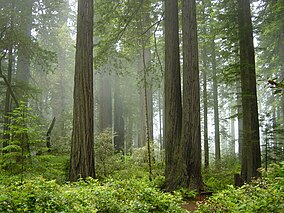
Back حدائق ريدوود الوطنية والحكومية Arabic ৰেডউড ৰাষ্ট্ৰীয় আৰু ৰাজ্যিক উদ্যান Assamese Taman Nasional Redwood BAN Redwood National and State Parks CEB پارکهای ملی و ایالتی ردوود Persian Redwoodin kansallispuistot Finnish מערכת הפארקים רדווד HE Taman Nasional Redwood ID Redwood-þjóðgarðarnir Icelandic レッドウッド国立公園 Japanese
| Redwood National and State Parks | |
|---|---|
IUCN category V (protected landscape/seascape) | |
 A forest of coast redwoods in fog | |
| Location | Humboldt County & Del Norte County, California, US |
| Nearest city | Crescent City |
| Coordinates | 41°18′N 124°00′W / 41.3°N 124°W |
| Area | 139,091 acres (562.88 km2)[1] |
| Established | October 2, 1968 |
| Visitors | 458,400 (in 2022)[2] |
| Governing body | National Park Service and California Department of Parks and Recreation |
| Website | nps |
| Criteria | Natural: (vii), (ix) |
| Reference | 134 |
| Inscription | 1980 (4th Session) |
The Redwood National and State Parks (RNSP) are a complex of one national park and three California state parks located in the United States along the coast of northern California. The combined RNSP contain Redwood National Park, Del Norte Coast Redwoods State Park, Jedediah Smith Redwoods State Park, and Prairie Creek Redwoods State Park. The parks' 139,000 acres (560 km2) preserve 45 percent of all remaining old-growth coast redwood forests.
Located in Del Norte and Humboldt counties, the four parks protect the endangered coast redwood (Sequoia sempervirens)—the tallest, among the oldest, and one of the most massive tree species on Earth—which thrives in the humid temperate rainforest. The park region is highly seismically active and prone to tsunamis. The parks preserve 37 miles (60 km) of pristine coastline, indigenous flora, fauna, grassland prairie, cultural resources, waterways, as well as threatened animal species, such as the Chinook salmon, northern spotted owl, and Steller's sea lion.
Redwood forest originally covered more than two million acres (8,100 km2) of the California coast, and the region of today's parks largely remained wild until after 1850. The gold rush and attendant timber business unleashed a torrent of European-American activity, pushing Native Americans aside and supplying lumber to the West Coast. Decades of unrestricted clear-cut logging ensued, followed by ardent conservation efforts. In the 1920s, the Save the Redwoods League helped create Prairie Creek, Del Norte Coast, and Jedediah Smith Redwoods State Parks among others. After lobbying from the league and the Sierra Club, Congress created Redwood National Park in 1968 and expanded it in 1978. In 1994, the National Park Service (NPS) and the California Department of Parks and Recreation combined Redwood National Park with the three abutting Redwoods State Parks into a single administrative unit. Modern RNSP management seeks to both protect and restore the coast redwood forests to their condition before 1850, including by controlled burning.
In recognition of the rare ecosystem and cultural history found in the parks, the United Nations designated them a World Heritage Site in 1980. Local tribes declared an Indigenous Marine Stewardship Area in 2023, protecting the parks region, the coastline, and coastal waters. Park admission is free except for special permits, and visitors may camp, hike, bike, and ride horseback along about 200 miles (320 km) of park system trails.
- ^ "National Park Service Acreage Reports". National Park Service. December 31, 2023. Archived from the original on September 22, 2022. Retrieved February 3, 2024.
- ^ "Annual Visitation Report by Years: 2012 to 2022". National Park Service. Archived from the original on November 10, 2017. Retrieved September 28, 2023.
© MMXXIII Rich X Search. We shall prevail. All rights reserved. Rich X Search

